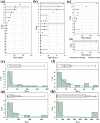Exploration of the potential association between GLP-1 receptor agonists and suicidal or self-injurious behaviors: a pharmacovigilance study based on the FDA Adverse Event Reporting System database
- PMID: 38355513
- PMCID: PMC10865629
- DOI: 10.1186/s12916-024-03274-6
Exploration of the potential association between GLP-1 receptor agonists and suicidal or self-injurious behaviors: a pharmacovigilance study based on the FDA Adverse Event Reporting System database
Abstract
Background: Establishing whether there is a potential relationship between glucagon-like peptide 1 receptor agonists (GLP-1RAs) and suicidal or self-injurious behaviors (SSIBs) is crucial for public safety. This study investigated the potential association between GLP-1RAs and SSIBs by exploring the FDA Adverse Event Reporting System (FAERS) database.
Methods: A disproportionality analysis was conducted using post-marketing data from the FAERS repository (2018 Q1 to 2022 Q4). SSIB cases associated with GLP-1RAs were identified and analyzed through disproportionality analysis using the information component. The parametric distribution with a goodness-of-fit test was employed to analyze the time-to-onset, and the Ω shrinkage was used to evaluate the potential effect of co-medication on the occurrence of SSIBs.
Results: In total, 204 cases of SSIBs associated with GLP-1RAs, including semaglutide, liraglutide, dulaglutide, exenatide, and albiglutide, were identified in the FAERS database. Time-of-onset analysis revealed no consistent mechanism for the latency of SSIBs in patients receiving GLP-1RAs. The disproportionality analysis did not indicate an association between GLP-1RAs and SSIBs. Co-medication analysis revealed 81 cases with antidepressants, antipsychotics, and benzodiazepines, which may be proxies of mental health comorbidities.
Conclusions: We found no signal of disproportionate reporting of an association between GLP-1RA use and SSIBs. Clinicians need to maintain heightened vigilance on patients premedicated with neuropsychotropic drugs. This contributes to the greater acceptance of GLP-1RAs in patients with type 2 diabetes mellitus or obesity.
Keywords: FAERS database; GLP-1RAs; Obesity; Pharmacovigilance; Suicidal or self-injurious behaviors; Type 2 diabetes.
© 2024. The Author(s).
Conflict of interest statement
The authors declare that they have no competing interests.
Figures



Similar articles
-
Association of GLP-1 Receptor Agonists With Risk of Suicidal Ideation and Behaviour: A Systematic Review and Meta-Analysis.Diabetes Metab Res Rev. 2025 Feb;41(2):e70037. doi: 10.1002/dmrr.70037. Diabetes Metab Res Rev. 2025. PMID: 39945396 Free PMC article.
-
Risk of ophthalmic adverse drug reactions in patients prescribed glucagon-like peptide 1 receptor agonists: a pharmacovigilance study based on the FDA adverse event reporting system database.Endocrine. 2025 Apr;88(1):80-90. doi: 10.1007/s12020-024-04112-8. Epub 2024 Nov 22. Endocrine. 2025. PMID: 39578328
-
Exploring the association between suicidal thoughts, self-injury, and GLP-1 receptor agonists in weight loss treatments: Insights from pharmacovigilance measures and unmasking analysis.Eur Neuropsychopharmacol. 2024 May;82:82-91. doi: 10.1016/j.euroneuro.2024.02.003. Epub 2024 Mar 19. Eur Neuropsychopharmacol. 2024. PMID: 38508100
-
Neuropsychiatric adverse events associated with Glucagon-like peptide-1 receptor agonists: a pharmacovigilance analysis of the FDA Adverse Event Reporting System database.Eur Psychiatry. 2025 Feb 4;68(1):e20. doi: 10.1192/j.eurpsy.2024.1803. Eur Psychiatry. 2025. PMID: 39901452 Free PMC article.
-
Review of head-to-head comparisons of glucagon-like peptide-1 receptor agonists.Diabetes Obes Metab. 2016 Apr;18(4):317-32. doi: 10.1111/dom.12596. Epub 2015 Dec 29. Diabetes Obes Metab. 2016. PMID: 26511102 Free PMC article. Review.
Cited by
-
Cardiovascular safety of Janus kinase inhibitors: A pharmacovigilance study from 2012-2023.PLoS One. 2025 May 12;20(5):e0322849. doi: 10.1371/journal.pone.0322849. eCollection 2025. PLoS One. 2025. PMID: 40354444 Free PMC article.
-
Suicidal Thoughts and Self-injurious Behavior Associated With Glucagon- Like Peptide-1 Receptor Agonists - A Review.Curr Drug Saf. 2025;20(3):253-257. doi: 10.2174/0115748863301925240507044637. Curr Drug Saf. 2025. PMID: 38766830 Review.
-
Depressive symptoms at short-, medium-, and long-term follow-up after bariatric surgical procedures: A systematic review and meta-analysis.Obes Rev. 2025 Aug;26(8):e13927. doi: 10.1111/obr.13927. Epub 2025 Apr 13. Obes Rev. 2025. PMID: 40222815 Free PMC article.
-
Adverse event profile of lorazepam: a real-world pharmacovigilance study using the FDA adverse event reporting system database.Front Pharmacol. 2024 Nov 22;15:1465245. doi: 10.3389/fphar.2024.1465245. eCollection 2024. Front Pharmacol. 2024. PMID: 39650163 Free PMC article.
-
Association of GLP-1 Receptor Agonists With Risk of Suicidal Ideation and Behaviour: A Systematic Review and Meta-Analysis.Diabetes Metab Res Rev. 2025 Feb;41(2):e70037. doi: 10.1002/dmrr.70037. Diabetes Metab Res Rev. 2025. PMID: 39945396 Free PMC article.
References
-
- Patorno E, Htoo PT, Glynn RJ, Schneeweiss S, Wexler DJ, Pawar A, et al. Sodium-glucose cotransporter-2 inhibitors versus glucagon-like peptide-1 receptor agonists and the risk for cardiovascular outcomes in routine care patients with diabetes across categories of cardiovascular disease. Ann Intern Med. 2021;174:1528–41. doi: 10.7326/M21-0893. - DOI - PMC - PubMed
-
- Davies MJ, Aroda VR, Collins BS, Gabbay RA, Green J, Maruthur NM, et al. Management of Hyperglycemia in Type 2 Diabetes, A consensus report by the american diabetes Association (ADA) and the European Association for the Study of Diabetes (EASD) Diabetes Care. 2022;45(11):2753–2786. doi: 10.2337/dci22-0034. - DOI - PMC - PubMed
MeSH terms
Substances
LinkOut - more resources
Full Text Sources
Medical

